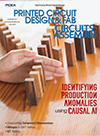Latest News
LOUISVILLE, KY -- Sypris Solutions reported a third-quarter net loss from continuing operations of $1.7 million, up from a net loss of $1.9 million for the prior year.
BANNOCKBURN, IL – Greenpeace regularly takes electronics companies to the woodshed for their environmental practices. Now IPC is turning the switch on Greenpeace.
Read more ...
MINNEAPOLIS -- Nortech Systems will acquire the EMS assets of Mankato, MN-based Winland Electronics for an undisclosed amount.
SAN JOSE – Third quarter worldwide silicon wafer area shipments rose sequentially to their highest levels ever, SEMI said.
WASHINGTON -- The National Association of Manufacturers is questioning pending US Environmental Protection Agency permitting guidance for greenhouse gas emissions. The new rules go in to effect Jan. 2.
SHENZHEN -- SinoHub, a contract designer and assembler of cellphones, said third-quarter net income climbed 55.3% from last year to $5.5 million.
BANNOCKBURN, IL – The European Parliament has decided to drop its demands for a list of new priority substances for restrictions under the RoHS Directive.
The list of four substances for priority assessment, also identified as “substances of very high concern” under REACH, was originally proposed by the EU Commission.
Parliament also dropped a demand for a revised RoHS Directive to contain a ban on nanosilver. In a compromise with member states, it opted for the mention of a future priority review of nanosilver.
All products will be covered eight years after the Directive enters into force.
In June, the Parliament's environment committee voted to expand the list to include almost 40 substances. These substances included BFRs, such as TBBPA, the most common flame retardant used in PCBs, despite the fact that TBBPA as used was found to be safe for human health and the environment by the World Health Organization and the European Commission Scientific Committee on Health and Environmental Risks.
Trade groups praised the decision. “Specifically mentioning entire classes of substances in a priority list would unfairly stigmatize them as being harmful to human health and the environment without a sound scientific basis,” said IPC in a press release today.
DUSSELDORF – Henkel reported third-quarter sales of 3.96 billion euros, up 13.7% year-over-year.
Operating profit rose 73% to 501 million euros. This is primarily due to substantial improvements of adhesive technologies.
The company’s Adhesives unit said quarterly sales were up 19.3%, reaching 1.95 billion euros, outpacing market growth in all regions. The unit includes the Multicore and Loctite brands, among others.
In the first nine months of fiscal 2010, Henkel increased sales 11.1% to 11.36 billion euros compared to the same period of 2009.
Operating profit was 1.34 billion euros, up 70.9% year-over-year.
“This is the first quarter we have ever achieved an adjusted EBIT margin of 13%,” said Kasper Rorsted, chairman of the Henkel management board.
“We expect to achieve an adjusted EBIT margin of well above 12% for 2010, accompanied by an improvement in adjusted earnings per preferred share of more than 45%. 2010 is likely to be the most successful fiscal year in our corporate history.”
1 euro = US$1.3657
MANKATO, MN -- EMS firm Winland Electronics narrowed its third-quarter net loss to $305,000 for the period ended Sept. 30.
TAIPEI -- Foxconn Electronics (Hon Hai) reported October revenues rose 49.8% year-over-year to NT$242.91 billion (US$8.05 billion). Sales slipped 4.2% from September's record mark on currency fluctuations.
MINNEAPOLIS – EMS firm Nortech Systems today reported third-quarter net sales of $26 million, up 39% year-over-year.
SCHAUMBURG, IL – Sparton Corp. reported first-quarter fiscal 2011 net income of $4.1 million, up 193% year-over-year.
Net sales were $45.8 million, down 4.9% compared to the same period last year, reflecting lower sales from the EMS segment due in part to the full disengagement from Honeywell during the first half of fiscal 2010.
EMS segment sales for the quarter were $12.3 million, down 30% compared to the same fiscal 2010 quarter. Gross profit for the segment was $907,000, down 10.9% year-over-year.
The gross profit percentage on EMS sales increased to 7%, compared to 6% for the same period last year.
"Within our EMS segment, we saw improved performance as a result of our aggressive cost improvement program," said Sparton president and CEO Cary Wood. "Volume, combined with continued production efficiencies, will be the key to sustained profitability of our EMS business. While current manufacturing schedules for the second quarter reflect lesser demand from certain customers in this segment, we remain confident in our ability to recover this sales volume in future quarters based on overall segment backlog and recent new business development wins."
Press Releases
- Kitron Strengthens Order Backlog with EUR 11 Million Contract for Defense Communication
- ZTEST Electronics Inc. Announces Transition to the OTCID Market
- SEMI and TechSearch International Release 2025 Edition of Worldwide Semiconductor Assembly & Test Facility Database
- Coherix Unveils Industry-First Service Program for Adhesive Dispensing Systems
POPULAR
- Editorial Contributions
- Smarter SMT Starts at the Reel: How Splicing Kits are Powering Efficiency
- Verifying PCBA Cleanliness with Ion Chromatography
- Factors Contributing to Solder Ball Formation: A Guide
- Systematic Troubleshooting in Electronics Assembly: A Case Study in Solder Balling and Process Optimization


